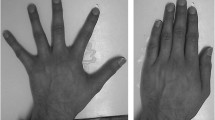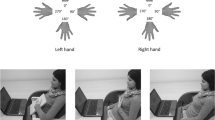Abstract
Several studies showed that mental rotation of body parts is interfered with by manipulation of the subjects’ posture. However, the experimental manipulations in such studies, e.g., to hold one arm flexed on one’s own chest, activated not only proprioceptive but also self-tactile information. Here, we tested the hypothesis that the combination of self-touch and proprioception is more effective than proprioception alone in interfering with motor imagery. In Experiment 1 right- and left-handers were required to perform the hand laterality task, while holding one arm (right or left) flexed with the hand in direct contact with their chest (self-touch condition, STC) or with the hand placed on a wooden smooth surface in correspondence with their chest (no self-touch condition, NoSTC); in a third neutral condition, subjects kept both arms extended (neutral posture condition, NPC). Right-handers were slower when judging hand laterality in STC with respect to NoSTC and NPC, particularly when the sensory manipulation involved their dominant arm. No posture-related effect was observed in left-handers. In Experiment 2, by applying the same sensory manipulations as above to both arms, we verified that previous results were not due to a conflict between perceived position of the two hands. These data highlighted a complex interaction between body schema and motor imagery, and underlined the role of hand dominance in shaping such interaction.




Similar content being viewed by others
References
Blakemore S-J, Sirigu A (2003) Action prediction in the cerebellum and in the parietal lobe. Exp Brain Res 153:239–245
Casasanto D (2009) Embodiment of abstract concepts: good and bad in right- and left-handers. J Exp Psychol Gen 138:351–367
Conson M, Sacco S, Sarà M, Pistoia F, Grossi D, Trojano L (2008) Selective motor imagery defect in patients with locked-in syndrome. Neuropsychologia 46:2622–2628
Conson M, Sarà M, Pistoia F, Trojano L (2009) Action observation improves motor imagery: specific interactions between simulative processes. Exp Brain Res 199:71–81
Conson M, Aromino AR, Trojano L (2010a) Whose hand is this? Handedness and visual perspective modulate self/other discrimination. Exp Brain Res 206:449–453
Conson M, Pistoia F, Sarà M, Grossi D, Trojano L (2010b) Recognition and mental manipulation of body parts dissociate in locked-in syndrome. Brain Cogn 73:189–193
Coslett HB, Lie E (2004) Bare hands and attention: evidence for a tactile representation of the human body. Neuropsychologia 42:1865–1876
de Lange FP, Helmich RC, Toni I (2006) Posture influences motor imagery: an fMRI study. Neuroimage 33:609–617
de Vignemont F, Ehrsson HH, Haggard P (2005) Bodily illusions modulate tactile perception. Curr Biol 15:1286–1290
Ehrsson HH, Kito T, Sadato N, Passingham RE, Naito E (2005) Neural substrate of body size: illusory feeling of shrinking of the waist. PLoS Biol 3:e412
Gentilucci M, Daprati E, Gangitano M (1998) Right-handers and left-handers have different representations of their own hand. Cogn Brain Res 6:185–192
Ionta S, Blanke O (2009) Differential influence of hands posture on mental rotation of hands and feet in left and right handers. Exp Brain Res 195:207–217
Ionta S, Fourkas AD, Fiorio M, Aglioti SM (2007) The influence of hands posture on mental rotation of hands and feet. Exp Brain Res 183:1–7
Lackner JR (1988) Some proprioceptive influences on the perceptual representation of body shape and orientation. Brain 111:281–297
Makin TR, Holmes NP, Ehrsson HH (2008) On the other hand: dummy hands and peripersonal space. Behav Brain Res 191:1–10
Maravita A, Spence C, Driver J (2003) Multisensory integration and the body schema: close to hand and within reach. Curr Biol 13:R239–R531
Master S, Tremblay F (2010) Selective increase in motor excitability with interactive (self) versus interactive touch. Neuroreport 21:206–209
Medina J, Coslett HB (2010) From maps to form to space: touch and the body schema. Neuropsychologia 48:645–654
Nico D, Daprati E, Rigal F, Parsons L, Sirigu A (2004) Left and right hand recognition in upper limb amputees. Brain 127:120–132
Oldfield RC (1971) The assessment and analysis of handedness: The Edinburgh inventory. Neuropsychologia 9:97–113
Parsons LM (1987) Imagined spatial transformations of one’s body. J Exp Psychol Gen 116:172–191
Parsons LM (1994) Temporal and kinematic properties of motor behavior reflected in mentally simulated action. J Exp Psychol Hum Percept Perform 20:709–730
Schütz-Bosbach S, Musil JJ, Haggard P (2009) Touchant-touché: the role of self-touch in the representation of body structure. Conscious Cogn 18:2–11
Schwoebel J, Coslett HB (2005) Evidence for multiple, distinct representations of the human body. J Cogn Neurosci 17:543–553
Sekiyama K (1982) Kinesthetic aspects of mental representations in the identification of left and right hands. Percept Psychophys 32:89–95
Serino A, Haggard P (2010) Touch and the body. Neurosci Biobehav Rev 34:224–236
Shenton JT, Schwoebel J, Coslett HB (2004) Mental motor imagery and the body schema: evidence for proprioceptive dominance. Neurosci Lett 370:19–24
Sirigu A, Duhamel JR (2001) Motor and visual imagery as two complementary but neurally dissociable mental processes. J Cogn Neurosci 13:910–919
Willems RM, Toni I, Hagoort P, Casasanto D (2009) Body-specific motor imagery of hand actions: neural evidence from right- and left-handers. Front Hum Neurosci 3:39
Willems RM, Peelen MV, Hagoort P (2010) Cerebral lateralization of face-selective and body-selective visual areas depends on handedness. Cereb Cortex 20:1719–1725
Author information
Authors and Affiliations
Corresponding authors
Rights and permissions
About this article
Cite this article
Conson, M., Mazzarella, E. & Trojano, L. Self-touch affects motor imagery: a study on posture interference effect. Exp Brain Res 215, 115–122 (2011). https://doi.org/10.1007/s00221-011-2877-7
Received:
Accepted:
Published:
Issue Date:
DOI: https://doi.org/10.1007/s00221-011-2877-7




